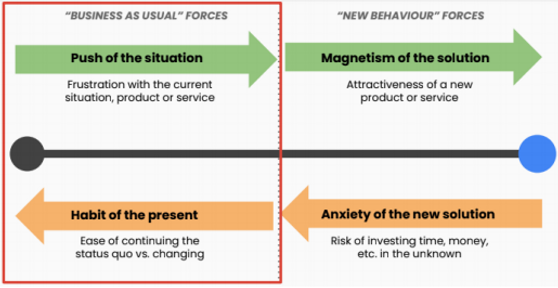
Date:
Mar. - Apr. 2021
Team:
Jordan Krueger, Daniela Mihajlovic, Salia Khalighmoeini, Jordan Migliazza
Course:
UXD5504 - Design for Change
Contributions: Data Collection, PESTEL Trend Analysis, Stakeholder Mapping, Empathy Mapping, Journey Mapping, Personas, Brainwriting, Ideation and UI Sketches, Prototype Development, Final Presentation

OBJECTIVE
Our collective over-consumption of textiles is leaving its mark on our environment, not only in terms of the waste generated from what has essentially become disposable clothing, but also the energy consumed and GHG produced to manufacture, transport, and distribute clothing.
In Canada, the average person throws out 81 pounds of textiles annually, we buy 60% more clothing today than we did 20 years ago, and we keep our clothes for half as long.
Overall, the fashion industry accounts for about 10% of global carbon emissions, and nearly 20% of wastewater.
As a result, embracing sustainable fashion is an essential step in the fight for climate change to reducing our carbon footprint. Our goal with this project was to develop a product or service to provide accessibility to sustainable fashion, and generate awareness regarding the environmental impact of the fashion industry.

_edited.png)
PROCESS


Before choosing this problem space, our team ran a PESTEL Trend Analysis to identify trends that may take place over a 10-20-year time frame. These trends were to focus on a potential municipal initiative focused on influencing human behavior to support improvements for climate change. Through this research, we were introduced to the concept of fast fashion and its impacts on global warming, which lead to us to exploring sustainable fashion, and investigating current products and services that aim to reduce carbon emissions and wastewater production.
Our group then performed a Stakeholder Scan to analyze stakeholders within the fashion industry and determine the impact each of them have. A Progress Making Forces diagram was then made to visualize the potential forces the selected stakeholders may face.
The team then constructed a Research Proposal outlining the objectives, research findings, intended outcomes, required data, research methodology, and the proposed timeline for completion.
.jpg)
Our group then began to generate potential solutions through Brainwriting techniques that address the problems identified within the problem space. After discussing several ideas, the group narrowed down our solution to a clothing donation / rental app where users could donate items and rent out others. A Customer Journey Map was then constructed to analyze the stakeholders thoughts and actions, and how they would apply them to our proposed service model.
.jpg)
END RESULT
Our final concept became ShareWear, a subscription service where people in the GTHA community may strive to make the world a better place by joining a collective community of people who contribute clothing items and rent others by using a point system.
Each month, the user who is opted in will receive points based on their subscription type. These points allow them to get as many items as they can with the amount of points they’ve accumulated. Subscribers to ShareWear reap the benefits of spending less money on clothing overall, reducing the demand for non-sustainable clothing practices, and thereby helping save the planet. They can even gain points to spend on clothing rentals when they contribute pieces from their own wardrobe.









